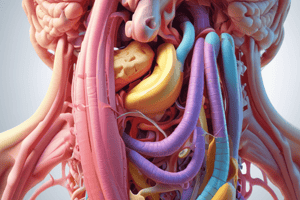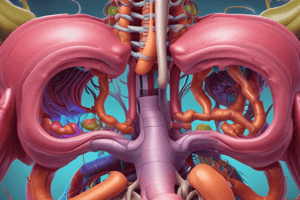Podcast
Questions and Answers
What is the basic structure of the alimentary canal?
What is the basic structure of the alimentary canal?
- Irregular structure without a defined lumen
- Spherical structure with multiple compartments
- Flat structure with no specific layers
- Tubular structure with histologic layers surrounding a lumen (correct)
Which organs are part of the large intestine?
Which organs are part of the large intestine?
- Duodenum, jejunum, ileum
- Liver, gall bladder, pancreas
- Cecum, appendix, ascending, transverse, descending colon, rectum (correct)
- Esophagus, stomach, small intestine
What do the accessory digestive organs do?
What do the accessory digestive organs do?
- Provide structural support to the alimentary canal
- Directly contact food and absorb nutrients
- Facilitate mechanical breakdown of food
- Function as glands that secrete substances into the alimentary canal (correct)
What is the embryological origin of the liver and pancreas?
What is the embryological origin of the liver and pancreas?
What is the main function of the alimentary canal?
What is the main function of the alimentary canal?
Which layer of the alimentary canal contains larger glands and Meissner’s plexus?
Which layer of the alimentary canal contains larger glands and Meissner’s plexus?
What regulates the inner circular and outer longitudinal layers of the muscularis?
What regulates the inner circular and outer longitudinal layers of the muscularis?
What is the function of the serosa in the alimentary canal?
What is the function of the serosa in the alimentary canal?
What is the role of the esophagus in the digestive system?
What is the role of the esophagus in the digestive system?
What is the main function of the stomach in the digestive system?
What is the main function of the stomach in the digestive system?
Which organ is the main site of digestion, absorption, and secretion in the digestive system?
Which organ is the main site of digestion, absorption, and secretion in the digestive system?
What optimizes the surface area for absorption in the small intestine?
What optimizes the surface area for absorption in the small intestine?
What is the main function of the large intestine in the digestive system?
What is the main function of the large intestine in the digestive system?
Which organs are considered accessory in the digestive system?
Which organs are considered accessory in the digestive system?
What is the involuntary contraction of the abdominal musculature, usually accompanied by severe pain?
What is the involuntary contraction of the abdominal musculature, usually accompanied by severe pain?
Which condition often causes a large liver with a firm, nontender edge?
Which condition often causes a large liver with a firm, nontender edge?
What does decreased bowel sounds often suggest?
What does decreased bowel sounds often suggest?
What can be a cause of increased bowel sounds?
What can be a cause of increased bowel sounds?
What is the most likely cause of abdominal pain in the hypogastric region?
What is the most likely cause of abdominal pain in the hypogastric region?
What is the voluntary contraction of the abdominal musculature due to abdominal discomfort?
What is the voluntary contraction of the abdominal musculature due to abdominal discomfort?
What is the time duration recommended to listen before assuming absence of bowel sounds?
What is the time duration recommended to listen before assuming absence of bowel sounds?
What can cause a palpable liver without necessarily indicating hepatomegaly?
What can cause a palpable liver without necessarily indicating hepatomegaly?
What is the cause of abdominal pain in the left iliac region?
What is the cause of abdominal pain in the left iliac region?
What is the cause of abdominal pain in the epigastric region?
What is the cause of abdominal pain in the epigastric region?
What is the cause of increased bowel sounds?
What is the cause of increased bowel sounds?
What is the cause of decreased bowel sounds?
What is the cause of decreased bowel sounds?
Flashcards are hidden until you start studying
Study Notes
Alimentary Canal and Digestive System Overview
- The alimentary canal performs propulsion, secretion, digestion, absorption, and immune function.
- The canal is made up of layers including mucosa, submucosa, muscularis, and outer layers.
- The submucosa contains larger glands and a network of neurons known as Meissner’s plexus.
- The muscularis has inner circular and outer longitudinal layers regulated by Auerbach’s plexus.
- The outer layer can be adventitia or serosa, with the serosa secreting peritoneal fluid.
- The peritoneal cavity is the fluid-filled gap between the abdominal wall and organs.
- The esophagus is a 25cm tube for food propulsion and has upper and lower sphincters.
- The stomach expands to store food, aids in mechanical and chemical digestion, and regulates food intake.
- The small intestine is the main site of digestion, absorption, and secretion with three components.
- The highly folded epithelium and mucosa of the small intestine optimize surface area for absorption.
- The large intestine mainly absorbs water and houses gut microbes.
- Accessory organs like the liver, gallbladder, and pancreas play vital roles in digestion and metabolism.
Studying That Suits You
Use AI to generate personalized quizzes and flashcards to suit your learning preferences.




